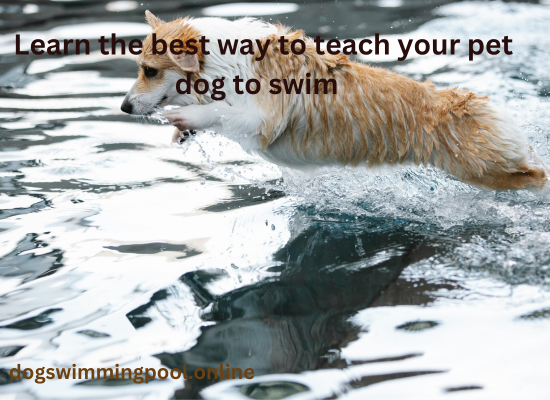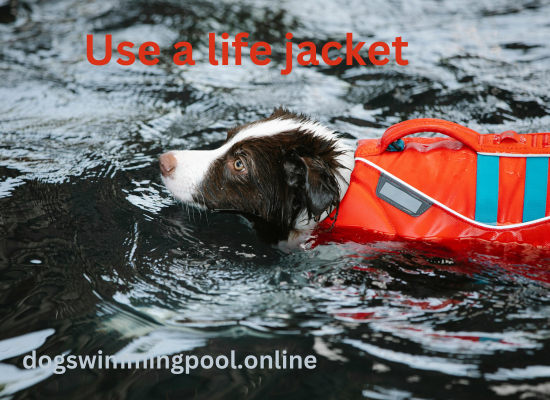Begin your dog’s swimming journey slowly in shallow water using positive reinforcement to build confidence. Always supervise with a life jacket to ensure safety and be patient whenever they learn.
Swimming is one of the best types of exercise for dogs. It is low-impact, and the high velocity of the water puts very little impact and stress on their joints. It is mostly better for dogs that have joint and muscle problems. Staying in the water for longer periods boosts swimming confidence even more and creates an emotional connection. It also provides an opportunity for physical and mental stimulation for both humans and dogs.

Can all dogs swim?
Generally, all dogs know how to swim naturally Most dogs love to swim in water so they like to spend most of their time in the water. but some dogs are not good at swimming so they are afraid to jump into the water. Breeds with physical characteristics such as water-resistant coats and webbed paws, like most labrador retrievers, are often better swimmers. These dogs are quite skilled at swimming, but retriever dogs are not exceptional swimmers the dog breeds that are most popular for athletics are all included in them.
Portuguese Water Dog
Originally Portuguese dogs were used for fishing and water rescue because they have waterproof coats and webbed paws.
Newfoundland
Newfoundland dogs are large, but they are fairly strong swimmers despite their large size. because they have a thick double coat and webbed paws and are innately good at avoiding water. Which makes them stronger and better swimmers as well as lifesavers.
Chesapeake bay retriever
It was specifically bred to retrieve aquatic birds and the Chesapeake Bay Retriever has a thick and oily coat that helps repel water when swimming and is a very powerful swimmer. They are quite well known for their water tolerance and ability to recover in water.
Labrador retrievers
This breed is very fond of water and they have a very high natural swimming ability, so they are more famous for their natural swimming ability. They also have webbed paws and a waterproof coat that makes them strong and excellent swimmers.
If your dog does not have webbed paws and does not know how to swim, it is very important to pay attention to the following points to teach your beloved pet dog to swim:
- Let your dog drink water very slowly and make sure they feel safe and comfortable.
- Start with the shallow areas first and be sure to use reinforcements for more confidence Not all dogs enjoy swimming, so don’t force them into the water Instead, introduce them to water slowly.
- Keep a close eye on your pet when swimming and provide them with protective measures such as a life jacket for added protection and if possible, make sure the water is not too deep.
Senior dog swimming
Older dogs can also learn to swim because swimming can be more beneficial for older dogs and for dogs with muscle and joint problems. When introducing swimming to an older dog, there are a few things you’ll need to do differently.
Take it slow too
Senior dogs often have joint and muscle problems and physical limitations or health problems. That demands gentle behavior Start in a shallow area first and introduce them to water slowly. As their swimming experience increases, increase the length of water depth sessions.
Use a life jacket

Senior dogs may experience muscle weakness and joint pain, so make sure your pet wears a life jacket while swimming. A life jacket provides a lot of support in swimming, making their swimming time more enjoyable. It also ensures their safety. Along with safety, it also allows them to save energy.
Take frequent breaks
Taking frequent breaks while swimming is especially important for big dogs as they tire quickly, so monitor their energy levels closely. And give them more time to calm down.
Consult a doctor before swimming your pet dog
It is very important to consult a vet before taking your senior dog swimming, especially if it has any underlying health problems or mobility issues. A doctor can give you the best and most beneficial advice for safe swimming.
What would be the best way to teach a dog to swim?
Teaching a dog to swim involves a very gradual and quite positive approach. Following are some steps to help introduce your beloved pet to swimming.
- First, start in a shallow, calm area, such as a lake or pond, and never swim in an area with strong currents or rough waves, such as the ocean.
- Start by letting your pet explore the water at their own pace. They can use up-pool toys to dip their paws underwater and reach the edge.
- For dogs that are more afraid of swimming in water or are new to swimming, introduce them to water very slowly. And walk in the shallows with your pet dog so that he can adjust slowly.
- Be ready to help them at all times. For dogs who are more afraid of water, a strap can be used. As your dog gains confidence in swimming, he will begin to enjoy the water.
- Reward your dog’s progress and efforts with positive reinforcement. For example, behavior praise and encouragement will go a long way in helping your dog develop a positive association with swimming.
- As your pet gains confidence in swimming in shallow water, gradually increase the depth and help them whenever they need help.
- Encourage your dog to paddle and use your hands or toys to get through the water. Be sure to praise and encourage their efforts.
- Always supervise your dog while swimming in the pool. be aware of their energy levels monitor for signs of fatigue help them whenever they need help and take rest breaks when needed.
- Make sure the pool your pet is swimming in is clear of hazards and easily accessible for exiting the pool.
Some essential dog safety tips while swimming
Water quality
Chemicals like chlorine are commonly used to keep pond water clean. And if chlorine is used in the pool in the right amount, it may be safe for humans, but it can be dangerous for dogs. It can irritate dogs’ skin, eyes, and nose.
It is very important to ensure that the pond water is properly balanced and that exposure to chemicals is minimized.
In contrast, natural bodies of water, such as oceans and lakes, have their water structure but may harbor bacteria, parasites, or other potential hazards.
Be sure to check with local public works officials about water conditions before allowing your pet to swim in the water.
Read more: Dog Hair in the Pool During Swim The Solution to Keeping Pools Free of Dog Hair
Not all swimming spots are created equal, and when it’s time for your pet to dive, there are significant differences between oceans, pools, and lakes.
Water in areas like the Great Lakes (including states like Michigan, Ohio, and Wisconsin) Fast Florida and Texas especially in stagnant waters May suffer from toxic algae blooms.
These toxins produced by bacteria can be fatal to dogs who may ingest them by drinking contaminated water or licking their skin after swimming.
Most local authorities provide updates on water conditions Avoid bodies of water with visible algae or that appear stagnant as these can pose a significant hazard.
Access and safety
Pools usually have fairly well-defined entrances and exits, making Doug’s swimming experience much easier to control and manage.
They must have ramps or stairs to enter the pool so that the dog can get in and out of the pool without any problems. Access points to open bodies of water may vary. Some areas also have steep or slippery edges.
Pet owners should make sure they have exits for dogs to get in and out of the pool. Consider, for example, current waves that can affect safety.
Distractions and stimuli
Pools are usually a controlled environment with few distractions that offer a more relaxing swimming experience for dogs.
Open bodies of water such as lakes or oceans can expose dogs to various stimuli such as waves, currents, wildlife, and other dogs or people. All these factors can affect the dog’s calmness and behavior during swimming.
Read more: Best indoor dog swimming: A safe fun way to keep the dog active
Visibility
A pool is one whose water is usually crystal clear so that both the dog and the dog’s owner can easily see each other underwater, and in open bodies of water, the water is clear enough for waves or vegetation.
Pet dogs often need to rely more on their swimming skills and instincts to navigate these situations and be close to dog owners.
Read more: High-quality swimming pools for small dogs
Best swimming accessories for dogs
While swimming with your beloved pet dog, there are a few special things to keep in mind to ensure their safety, comfort, and fun. Consider them
- A life jacket is very important for the safety of the dog
- Dry your pet with a clean towel immediately after swimming.
- A bowl of clean water for them to drink, a collapsible water bowl for easy access, or a portable table water dispenser is a must-line.
- DOG-FRIENDLY SUNSCREEN TO PROTECT FROM DANGEROUS UV RAYS Be sure to check with your veterinarian for the perfect sunscreen options for your pet if needed.
- Swim toys in the pool
- First aid kit
- Lea and collar harness with ID tags
- The items you need may vary depending on your dog’s needs and any specific requirements or regulations in the area.
- Prioritize your dog’s safety and the fun of your pet dog’s swimming.
Conclusion
Finally, teaching your dog to swim can be a rewarding experience for both you and your pet. It offers physical exercise and mental stimulation by starting in shallow, calm water, using positive reinforcement and appropriate equipment such as a life jacket. Ensuring safety with devices is a gradual approach. Every dog is unique, so it’s important to be patient, respect their comfort level, and tailor the experience to their needs, whether your dog is a natural swimmer or needs a little more encouragement. Swimming can be a fun and rewarding activity and promotes overall health.
Read more: Water is essential for dogs so choosing the best swimming pool for them.
FAQS
How to train a dog to swim in a swimming pool?
- Introduce your dog to shallow water first and start very slowly
- Use positive reinforcement for calm behavior eg treats and praise
- Let them explore water at speed Gradually increase the depth of the water
- And make sure the water is safe and not too cold for Aram
- If your dog is afraid to swim in the water, consider using pool toys or treats to encourage them.
Can dogs learn to like swimming?
- Yes, many dogs can learn to enjoy swimming with positive patience and experience.
- Start with short fun sessions and slowly build their trust
- Some breeds are naturally better swimmers but all dogs can be taught with gentle encouragement.
How do you swim like a dog?
- Dogs usually use a natural instinctive dog paddle stroke Keeping your body horizontal in the water, move your legs in a circular motion.
- To imitate this, keep your legs and arms slightly bent and try pedaling with both arms and legs at the same time.
How to swim for beginners?
- Start slowly in shallow water where you can touch the bottom
- Practice swimming on your back And slowly kick your legs
- Keep your head above water and focus on breathing continuously
- Try to learn basic strokes like freestyle or smooth movements breaststroke in calm water with soft strokes.